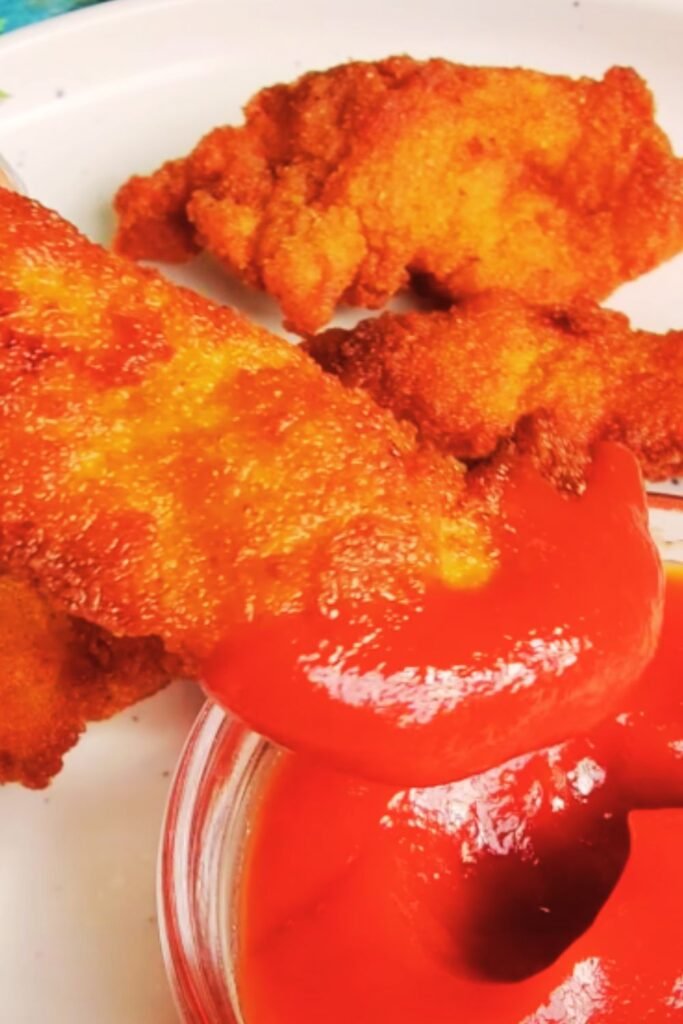When I first heard the name “Crack Chicken Tenders,” I’ll admit I was both intrigued and slightly puzzled. But after making this recipe countless times and watching friends and family devour every last piece, I completely understand why they earned this bold moniker. These aren’t your ordinary chicken tenders – they’re an explosion of flavor that combines the comfort of classic fried chicken with an addictive blend of seasonings and a creamy, tangy coating that makes them absolutely irresistible.
The beauty of crack chicken tenders lies in their perfect balance of textures and flavors. Picture this: tender, juicy chicken strips coated in a seasoned flour mixture, then dredged in a creamy ranch and cream cheese blend that creates the most incredible crust when cooked. The result is chicken tenders that are crispy on the outside, succulent on the inside, and packed with flavor in every single bite.
What sets these apart from regular chicken tenders is the unique coating system. Instead of just using egg wash, I incorporate cream cheese and ranch dressing powder into the wet mixture, which creates an extra layer of flavor and helps achieve that signature golden-brown crust that everyone raves about. The combination of herbs, spices, and that tangy ranch flavor makes these tenders absolutely addictive – hence the name “crack” chicken tenders.
What Makes Crack Chicken Tenders So Special
The magic behind these incredible chicken tenders lies in several key components that work together harmoniously. First, there’s the protein preparation – I always use fresh chicken tenderloins or cut chicken breasts into strips myself rather than buying pre-cut tenders. This ensures maximum freshness and allows me to control the size and thickness for even cooking.
The seasoning blend is where things get really interesting. I combine traditional Southern-style seasonings like paprika, garlic powder, and onion powder with ranch dressing mix, which adds that distinctive tangy flavor profile that makes these tenders so craveable. The ranch powder isn’t just mixed into the coating – it’s also incorporated into the wet mixture, creating layers of flavor throughout.
Key Flavor Components:
- Ranch dressing powder for tanginess
- Cream cheese for richness and moisture
- Paprika for color and subtle smokiness
- Garlic and onion powders for savory depth
- Cayenne pepper for a gentle heat kick
- Italian seasoning for herbal complexity
The coating process involves a three-step system that ensures maximum flavor penetration and the perfect texture. Unlike traditional chicken tenders that might use just flour and egg, my crack chicken tenders go through a seasoned flour dredge, then a cream cheese and ranch mixture, and finally back into the seasoned flour for that extra-crispy exterior.
Essential Ingredients and Their Roles
Understanding each ingredient’s purpose helps you appreciate why this recipe works so brilliantly and allows you to make substitutions if needed while maintaining the integrity of the dish.
Chicken Selection:
- Chicken Tenderloins: These are my preferred choice because they’re naturally tender, cook evenly, and have the perfect size for this preparation
- Chicken Breast Alternative: If using chicken breasts, cut them into strips about ½ inch thick and 3-4 inches long
The Coating System:
- All-Purpose Flour: Forms the base of both coating layers and helps create structure
- Ranch Dressing Mix: The star ingredient that provides the signature tangy, herby flavor
- Cream Cheese: Softened to room temperature, this adds richness and helps the coating adhere
- Eggs: Bind the wet mixture and help create the perfect coating consistency
Seasoning Blend:
- Paprika: Adds beautiful color and subtle smoky flavor
- Garlic Powder: Provides savory depth without overwhelming freshness
- Onion Powder: Complements the garlic and adds another layer of umami
- Cayenne Pepper: Just enough to add warmth without making it spicy
- Italian Seasoning: Brings herbal complexity with oregano, basil, and thyme
- Salt and Black Pepper: Essential for balancing and enhancing all other flavors
Detailed Preparation Method
Creating perfect crack chicken tenders requires attention to detail and proper technique. I’ve refined this method through numerous trials to ensure consistent, restaurant-quality results every time.
Preparation Phase:
Start by setting up your workspace with three shallow dishes for the coating process. This organization is crucial for maintaining efficiency and preventing cross-contamination. Remove the chicken from refrigeration about 15 minutes before cooking to allow it to come closer to room temperature, which ensures more even cooking.
If you’re using chicken breasts instead of tenderloins, slice them into strips approximately ½ inch thick. The key is maintaining consistent thickness so all pieces cook at the same rate. Pat each piece completely dry with paper towels – excess moisture is the enemy of a crispy coating.
Coating Station Setup:
Station 1 – Seasoned Flour Mixture: Combine 2 cups all-purpose flour with 1 packet ranch dressing mix, 1 tablespoon paprika, 1 teaspoon garlic powder, 1 teaspoon onion powder, ½ teaspoon cayenne pepper, 1 teaspoon Italian seasoning, 1 teaspoon salt, and ½ teaspoon black pepper. Whisk thoroughly to ensure even distribution.
Station 2 – Cream Cheese Mixture: In a separate bowl, blend 8 oz softened cream cheese with 2 large eggs and 2 tablespoons of the ranch seasoning mix. Mix until completely smooth – any lumps will create uneven coating.
Station 3 – Final Flour Coating: Use the remaining seasoned flour mixture from Station 1.
The Coating Process:
Each chicken tender goes through this specific sequence: seasoned flour, cream cheese mixture, then back to seasoned flour. This double-dredging technique creates an incredibly thick, flavorful coating that stays put during cooking.
First, dredge each tender in the seasoned flour, shaking off excess. Next, dip into the cream cheese mixture, ensuring complete coverage. Finally, return to the seasoned flour for the final coating, pressing gently to help it adhere.

Place coated tenders on a wire rack set over a baking sheet. This prevents the coating from becoming soggy on the bottom and allows air circulation around each piece.
Cooking Methods and Techniques
I’ve experimented with various cooking methods for crack chicken tenders, and while deep frying produces the most traditional results, I’ve developed excellent alternatives for different preferences and dietary needs.
Deep Frying Method (Traditional)
Heat oil to 350°F (175°C) in a heavy-bottomed pot or deep fryer. The oil temperature is critical – too hot and the coating burns before the chicken cooks through; too cool and you’ll get greasy, soggy results.
Fry tenders in small batches to avoid overcrowding, which drops the oil temperature. Cook for 3-4 minutes per side until golden brown and the internal temperature reaches 165°F (74°C). Remove with a slotted spoon and drain on paper towels.
Air Fryer Method (Healthier Alternative)
Preheat your air fryer to 400°F (200°C). Lightly spray the basket with cooking oil to prevent sticking. Cook tenders for 8-10 minutes, flipping halfway through. The air fryer creates excellent results with significantly less oil.
Oven Baking Method (Family-Friendly)
Preheat oven to 425°F (220°C). Place coated tenders on a wire rack set over a baking sheet. Lightly spray with cooking oil for better browning. Bake for 15-18 minutes, flipping once, until golden and cooked through.
Pan Frying Method (Stovetop)
Heat about ½ inch of oil in a large skillet over medium-high heat. Cook tenders for 3-4 minutes per side until golden brown and cooked through. This method uses less oil than deep frying but still produces crispy results.
Nutritional Information and Serving Suggestions
Understanding the nutritional profile of crack chicken tenders helps you incorporate them into your meal planning effectively.
| Nutritional Component | Per Serving (3 tenders) | Daily Value % |
|---|---|---|
| Calories | 385 | 19% |
| Total Fat | 18g | 23% |
| Saturated Fat | 8g | 40% |
| Cholesterol | 95mg | 32% |
| Sodium | 890mg | 39% |
| Total Carbohydrates | 22g | 8% |
| Dietary Fiber | 1g | 4% |
| Sugars | 2g | – |
| Protein | 32g | 64% |
| Vitamin A | 15% | – |
| Calcium | 8% | – |
| Iron | 12% | – |
Serving Size Considerations: The recipe typically yields 6-8 servings, with each serving consisting of 2-3 tenders depending on size. These are quite rich due to the cream cheese coating, so they’re quite satisfying.
Pairing Suggestions:
Side Dishes:
- Creamy coleslaw provides a cool, crunchy contrast
- Roasted sweet potato fries add natural sweetness
- Garlic mashed potatoes for ultimate comfort food
- Fresh corn salad brings brightness and color
- Steamed broccoli adds nutritional balance
Dipping Sauces:
- Honey mustard sauce complements the ranch flavors
- Buffalo sauce for heat lovers
- Buttermilk ranch for extra ranch flavor
- Barbecue sauce adds smoky sweetness
- Sriracha mayo brings Asian-inspired heat

Beverage Pairings:
- Sweet iced tea perfectly balances the savory coating
- Lemonade provides refreshing acidity
- Sparkling water with lime cleanses the palate
- Cold milk offers creamy comfort
- Fresh fruit juices add natural sweetness
Storage and Reheating Tips
Proper storage ensures your crack chicken tenders maintain their quality and safety for future enjoyment.
Refrigerator Storage: Store cooled tenders in an airtight container in the refrigerator for up to 3 days. Place parchment paper between layers to prevent sticking and maintain coating integrity.
Freezer Storage: For longer storage, freeze tenders in a single layer on a baking sheet first, then transfer to freezer bags. This prevents them from sticking together. Properly frozen tenders maintain quality for up to 3 months.
Reheating Methods:
Oven Reheating (Best for Crispiness): Preheat oven to 375°F (190°C). Place tenders on a wire rack over a baking sheet and heat for 8-10 minutes until warmed through and crispy.
Air Fryer Reheating: Heat at 350°F (175°C) for 3-4 minutes. This method excellently restores crispiness.
Microwave Reheating (Quick but Less Crispy): Heat in 30-second intervals until warm, though this method softens the coating.
Troubleshooting Common Issues
Even experienced cooks encounter challenges when making crack chicken tenders. Here are solutions to the most common problems I’ve encountered and helped others solve.
Coating Falls Off During Cooking: This usually happens when the chicken is too wet or the coating isn’t properly adhered. Always pat chicken completely dry and press the final flour coating firmly onto each tender. Let coated tenders rest for 10-15 minutes before cooking to help the coating set.
Coating Burns Before Chicken Cooks: Oil temperature is too high. Maintain 350°F (175°C) for deep frying. If using other methods, reduce temperature slightly and increase cooking time.
Tenders Are Dry: Overcooking is the culprit. Use a meat thermometer to ensure internal temperature reaches exactly 165°F (74°C). Remove from heat immediately upon reaching this temperature.
Uneven Browning: This indicates uneven oil temperature or overcrowded cooking surface. Cook in smaller batches and maintain consistent heat.
Soggy Coating: Usually caused by oil that’s not hot enough or improper draining. Ensure oil reaches proper temperature before adding chicken, and drain on wire racks rather than paper towels when possible.
Variations and Customizations
The basic crack chicken tender recipe serves as an excellent foundation for numerous delicious variations that cater to different tastes and dietary preferences.
Spicy Variations:
- Add 1-2 teaspoons hot sauce to the cream cheese mixture
- Incorporate 1 teaspoon chipotle powder into the flour mixture
- Mix cayenne pepper with the final flour coating for extra heat
- Use spicy ranch dressing mix instead of regular
Herb and Flavor Combinations:
- Mediterranean style: Add dried oregano, basil, and sun-dried tomato powder
- Mexican inspired: Include cumin, chili powder, and lime zest
- Asian fusion: Incorporate garlic powder, ginger powder, and sesame seeds
- Southern comfort: Extra paprika, onion powder, and a touch of brown sugar
Dietary Modifications:
- Gluten-free: Substitute almond flour or gluten-free flour blend
- Lower sodium: Use low-sodium ranch mix and reduce added salt
- Dairy-free: Replace cream cheese with vegan cream cheese alternative

Frequently Asked Questions
Q: Can I make crack chicken tenders ahead of time? I often prepare these tenders up to the coating stage and refrigerate them for up to 24 hours before cooking. This actually helps the flavors meld and often results in even better taste. Just let them come to room temperature for about 15 minutes before cooking.
Q: Why is my coating not sticking properly? The most common reason is excess moisture on the chicken. Always pat the chicken completely dry with paper towels before beginning the coating process. Also, make sure your cream cheese is at room temperature and well-mixed with the eggs to create a smooth, cohesive mixture.
Q: Can I use chicken thighs instead of breasts or tenderloins? Absolutely! Boneless, skinless chicken thighs work wonderfully and actually stay more moist during cooking. Cut them into strips similar in size to tenderloins. You might need to adjust cooking time slightly as thighs can take a minute or two longer.
Q: How do I know when the oil is the right temperature for frying? A cooking thermometer is the most accurate method – aim for 350°F (175°C). If you don’t have a thermometer, drop a small piece of bread into the oil. It should sizzle immediately and turn golden brown in about 60 seconds.
Q: Can I bake these instead of frying for a healthier option? Yes, baking works great! Preheat your oven to 425°F (220°C), place tenders on a wire rack over a baking sheet, lightly spray with cooking oil, and bake for 15-18 minutes, flipping once halfway through.
Q: What’s the best way to reheat leftover crack chicken tenders? For the crispiest results, reheat in a 375°F (190°C) oven for 8-10 minutes on a wire rack. An air fryer also works excellently at 350°F (175°C) for 3-4 minutes.
Q: Can I freeze the coated but uncooked tenders? Yes! Place coated tenders on a baking sheet in a single layer and freeze until solid, then transfer to freezer bags. Cook directly from frozen, adding 2-3 minutes to the cooking time.
Q: Why are they called “crack” chicken tenders? The name comes from how addictive they are! The combination of creamy, tangy ranch flavors with the crispy coating makes them incredibly hard to stop eating – people often joke that they’re “addictive like crack.”
Q: Can I make my own ranch seasoning mix? Certainly! Mix together 1 tablespoon dried dill, 1 tablespoon dried parsley, 2 teaspoons garlic powder, 2 teaspoons onion powder, 1 teaspoon dried onion flakes, 1 teaspoon salt, and ½ teaspoon black pepper.
Q: What sides pair best with crack chicken tenders? I love serving them with cooling sides like coleslaw or cucumber salad to balance the rich coating. Sweet potato fries, corn on the cob, and fresh fruit also complement them beautifully.
The beauty of crack chicken tenders lies not just in their incredible flavor, but in their versatility and the joy they bring to any meal. Whether I’m making them for a casual family dinner, a game day gathering, or meal prep for the week, they never fail to impress. The combination of that crispy, flavorful coating with tender, juicy chicken creates a dish that truly lives up to its bold name.
What makes this recipe particularly special is how it transforms simple ingredients into something extraordinary. The ranch seasoning and cream cheese coating might seem unconventional, but together they create a flavor profile that’s both familiar and exciting. Every bite delivers that perfect contrast of textures and the kind of satisfying taste that keeps everyone coming back for more.
I encourage you to try this recipe and make it your own. Whether you stick to the classic version or experiment with the variations I’ve suggested, I’m confident these crack chicken tenders will become a favorite in your household just as they have in mine. The combination of ease of preparation and absolutely delicious results makes this a recipe you’ll return to again and again.